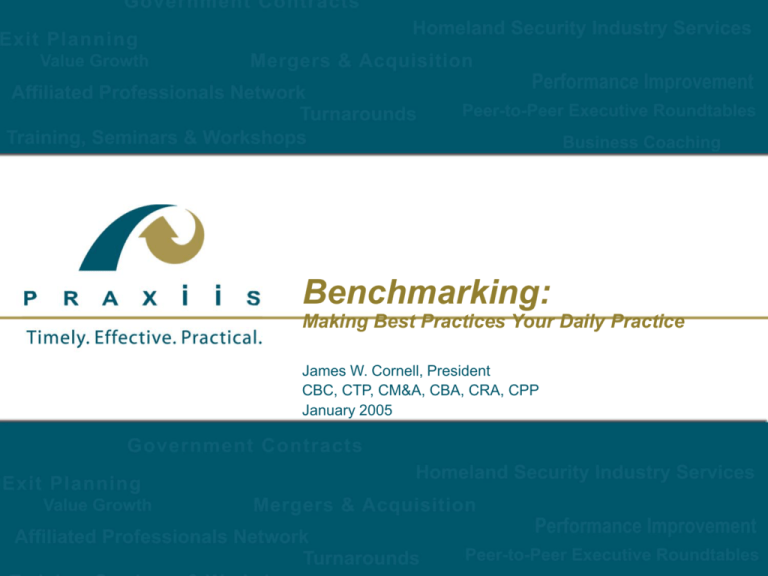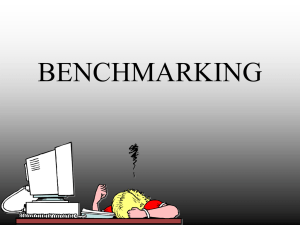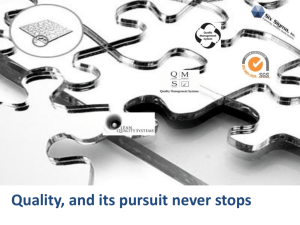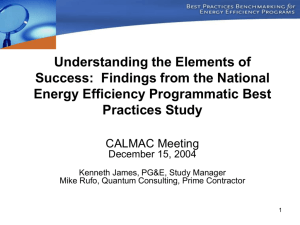Benchmarking
advertisement

Benchmarking: Making Best Practices Your Daily Practice James W. Cornell, President CBC, CTP, CM&A, CBA, CRA, CPP January 2005 Praxiis Business Advisors Our mission is to help private and corporate business owners create strategies for high performance & competitive dominance, drive value growth, and when ready devise and execute the most profitable exit through a predetermined succession plan or sale of the business. Praxiis Business Advisors Corporate Renewal, Growth & Transaction Advisors to Small and MidMarket Businesses and their Stakeholders. Established as Strategic Corporate Services in 1988. Primary offices are in Western NY and services are delivered nationally. Affiliated Professionals possess academic credentials including B.S. Business Management & Economics, Master of Business Administration, Ph.D. in various disciplines, Juris Doctor and numerous professional designations. James W. (Jim) Cornell Founder and President of Praxiis Business Advisors 24 years as advisor to $1M - $4B Clients – Strategy, Turnarounds, Performance Improvement, Value Growth, Exit Planning, M&A, Government Contracting Principal in numerous mid-market turnarounds, including – National security services firm – Internationally recognized manufacturer of engineered fabric structures – DOD and Industrial Paint & Coatings manufacturer Lead advisor for successful turnaround of $50M DOJ Citizenship Benefits Processing program, & $1B+ major government contract wins (TVA, SPR) BS, Business Management & Economics, and MBA from SUNY Empire State College Governor, SUNY Empire State Federation Board of Governors Faculty, SUNY Empire State College FORUM Program Chair- Licensure Task Force Alliance of Merger and Acquisition Advisors Benchmarking Defined To measure the best practices of leading businesses, and learn and adapt them for use in your business A systematic comparison of two or more companies or units of companies to gauge their performance relative to a peer You Cant Improve What You Don’t Measure ! (and you can’t prove it to your customers either) Where Did it Start? Xerox Corporation 20 years ago – Canon was “eating their lunch” Higher quality machines, lower price Embarked on a systematic campaign – Reverse engineered products – Studied competitors – Studied a wide range of firms in other industries A Discipline Emerged Malcolm Baldrige National Quality Award incorporated it a a criterion Many multi-step recipes emerged, all built around fundamentals.. – In “Benchmarking” by Camp, steps are Planning Analysis Integration Action Maturity – American Productivity & Quality Center Planning Data collection Analysis Adapting & Improving Two Types of Benchmarking "Metrics" give numerical standards against which a client’s own processes can be compared. Metric benchmarks are of the form: – Finished-product first-pass yield of 97% – Scrap/rework less than 1% of sales – Cycle time less than 25 hours – Customer lead times less than 20 days – Productivity levels of $150,000 or more per employee – Plant-level ROA better than 15% These metrics are usually determined via a detailed and carefully analyzed survey or interviews It’ All About the Data! Well, Maybe Not Always……… Two Types of Benchmarking “Process Benchmarking" is generally higher-level and less numbersintensive than metrics. – Demonstrate how top performing companies accomplish the specific process in question. – Takes form of research, surveys/interviews, and site visits. – By identifying how others perform the same functional task or objective, firms gain insight and ideas they may not otherwise achieve. – A true value-added feature of benchmarking Benefits of process benchmarking are realized when pursuing a strategy of changed processes – making marked improvements in productivity, costs, and revenues Best Practices Tactics and strategies employed by highly regarded companies Process benchmarking is particularly useful to develop BP, and our focus today Fundamental tool for driving change in contemporary organizations Why Benchmark? When done well, benchmarking prominently reveals gaps between the performance of the benchmarker and that of a “best practices” leader, and that leads to developing sustainable competitive advantage Why Don’t More Businesses Do Traditional Multi-step Benchmarking? Takes too long often six to nine months Its costly The lessons learned may or may not get translated to practice and improvement – Reports that get shelf space, not action – Cumbersome process to complete – Limits Flexibility - procedures oriented Put Another Way….. “Its like the mating of pandas: infrequent, clumsy and often ineffective” Chris Bogan, President and CEO of Benchmarking and Consulting How To Get It How To Evaluate It How to Use It Creative Benchmarking* Start from the customers point of view List each step of the customers buying experience Next, determine which factors most influence customers perception of value at each step Finally, identify companies that excel at each factor – without regard to their industry! * (derived from the work of Dawn Iacobucci and Christie Nordhielm, Kellogg Graduate School of Management) Entering, Occupying and Exiting a Hotel Room Enter Lobby – Physical Environment Functional, economical – Southwest Airlines, the Gap, Target, Sam’s Club Attractive, luxurious – Virgin Atlantic, Lexus car dealerships Greeting – Friendly, casual Wal-Mart, Club Med – Cordial, professional Nordstrom, Ritz-Carlton – Discrete Alcoholics Anonymous Entering, Occupying and Exiting a Hotel Room Check-In – Fast efficient service, no lines Express aisles in supermarkets, Hertz – Guaranteed maximum wait Bennigans Lunch Express – Pleasant Queue experience using pagers Cheesecake Factory Bellboy Carries Luggage – Attentive Employees Benihana Japanese Restaurants – Festive, informal impression Carnival Cruise Lines, Southwest – Sedate, formal impression Management consulting firms, Tiffany Entering, Occupying and Exiting a Hotel Room Use Shower – Good shower design Professional sports teams – Reliable plumbing maintenance SeaWorld Get Advice on Restaurants – Intelligent agents who know restaurants Electronic – Yahoo! Employees – Travel agents Agents who know their customers – Nordstrom Entering, Occupying and Exiting a Hotel Room Breakfast – Room service food arrives promptly, at appropriate temperature Delivery pizzerias – Courteous delivery personnel UPS Check-out – Quick, seamless departure, TV checkout Sega children’s games Intuits TurboTax Entering, Occupying and Exiting a Hotel Room Other areas for hotels to look for best practices…. – Choose Hotel – Make Reservation – Travel to Hotel – Park Rental Car – Walk to Hotel – Go to Room – Look Around Room – Require Assistance of a hotel employee – Call Home – Use Business Equipment – Workout – Retrieve Car – Head to Airport – Follow-up Fast-Cycle Benchmarking Less elaborate than traditional multi-step More tactical – What do concrete trucks and pizza have in common? Useful to Identify specific operation problems or opportunities Rather than simply copy from other firms, use the data to draw useful analogies and stimulate generation of creative ideas – Mobil and the Penske race team.. gas stations aren’t race teams, but the methods for quick turnaround led to the Speedpass Figure Out What You Are Looking For Replicate and bring it in, or Look for practices that can spark ideas, don’t just replicate what you find Figure out where benchmarking fits in your toolchest, and make an informed decision about the outcome you are really after Benchmark Companies Roughly at Your Own Level College physics before high school math doesn’t make any sense… – Forget the world class company (unless you are one!)..find a firm of similar size and situation as yours Benchmark companies with similar business needs – Common concerns promote a more productive exchange or transportability of the information learned Study the Entire System Rather Than One Technique Avoid cursory, superficial looks Mission statements, values and expectations of employees may be expressed as a document or pledge, but The real value is in how the firm inculcates the meaning in employees, and how they put it to work in their daily practices High performance systems only work when every single person in the organization is fully committed When Benchmarking a System, Adapt What You Find, Don’t Just Copy It Conditions are never identical You can pick up critical variables and apply them … Create a system – a comprehensive set of reinforcing practices that are responsible for success Benchmark Subjective Measures and Qualities Running a business today is far more of a creative process than in the past Quantitative measures are useful, but not all encompassing Using a creative process, benchmarking is a directional tool, not just a template Remember Why You Are Doing This Don’t get wrapped around the axle Don’t confuse measures with actually delivering a result from the effort Focus on the principles most applicable to your business It is not an end in itself, it is but a means to an end Step-by-Step - 1 You are the Process Owner Start by Working Alone – – – – List key ideas and best practices you believe your organization should consider Brainstorm List and rate your ideas relative to your organizations mission and strategy Identify timeframes within which each idea and practice could realistically be implemented Step-by-Step - 2 Share your analysis with other key members of your organization – Have them create similar lists and incorporate them into a master list – Discuss individual ratings – Develop consensus for importance and timing Step-by-Step - 3 Identify extended team members that are motivated – Work together to prepare list of top three ideas and best practices that should be implemented immediately – Identify key benefits expected to be gained from each – Develop the approach to be used to implement, problems expected, and how you will address them Step-by-Step - 4 As Group, list top 3 ideas and best practices that should be considered to implement in the next year – Identify and assign a key person to take the lead in analyzing implementation feasibility Step-by-Step - 5 Meet regularly as a team – Assess progress and identify new ideas – Discuss how to develop a culture of Entrepreneurship Innovation Accountability – All to keep the creative energy flowing Step-by-Step - 6 If the task seems too daunting engage a facilitator from outside the immediate organization to lead the process and establish accountabilities for the team Pitfalls When Not Done Well Failure to consider organizational cultures or circumstances leads to a wrong direction Insufficient preparation usually results in MBWAA (management by wandering around aimlessly!) – What are you trying to learn about? – Why do you want to learn it? – What will you do with it to make your processes better once you have it? Recognize You’re Not The Best Not invented here Humility and Determination is required to think outside the box Utilize the best ideas of others to build upon Processes can often be evaluated with numeric metrics A What Without a How Can Do More Harm Than Good The “hows” underlying the numbers are essential – They tell you if you are comparing “apples to apples” – They provide clues to how to alter methods to suit your culture or circumstance – They may reveal that a best-in-class measure isn’t cost effective, or that outsourcing may be in order Measure What’s Needed, Not What’s Easy Broad measures of performance fail to give you actionable information You don’t need a 1000 measures, just find the key indicators that serve as critical factors – eg employee turnover Finding balance is important..dont let a non-benchmarked metric go bad – Call center volume vs. hi-margin cross selling Find the Happy Medium in Frequency One shot benchmarking doesn’t gain continuing improvement Too often (weekly, monthly) makes you reactionary slaves to the numbers Speed of business is increasing, driving the frequency of benchmarking..things change quickly Involve Implementers from the Start Getting Buy-in is critical Involvement from planning to implementation of the people who need to implement findings conveys ownership Look for Benchmarking Opportunities Everywhere Internal and External In and out of industry Utilize Trade and other organizations (Runzheimer) Delivering Excellent Service: Lessons from the Best Firms Robert C. Ford Cherrill P. Heaton Stephen W. Brown California Management Review Vol 44, NO. 1 Fall 2001 Ten Essential Lessons 1. 2. 3. 4. 5. 6. 7. 8. 9. 10. Base decisions on what the customer wants and expects Think and act in terms of the entire customer experience Continuously improve all parts of the customer experience Hire and reward people who can effectively build relationships with customers Train employees in how to cope with their emotional labor costs Create and sustain a strong service culture Avoid failing your customers twice Empower customers to co-produce their own experience Get managers to lead from the front, not the top Treat all customers as if they were guests Resources Benchmarking for Best Practices: Winning Through Innovative Adaptation, Christopher Bogan and Michael English, McGraw Hill www.best-in-class.com – Bogan’s website The International Benchmarking Clearinghouse, www.apqc.org www.runzheimer.com The Business Gateway http://www.bgateway.com/index.asp Reference Sources and Readings Is Benchmarking Doing the Right Work? David Stauffer, Harvard Business School Publishing 2003 Key Ideas and Best Practices Analysis, Lynda M. Applegate, Harvard Business School Publishing, April 2002 Creative Benchmarking, D. Iacobucci and Christie Nordhielm, Harvard Business Review, 2000 Delivering Excellent Service: Lessons from the best firms, Ford, Heaton and Brown, California Management Review, 2001 Thank You! Additional Areas For Discussion Spider Diagram Balanced Scorecard The ‘Spider’ Diagram The spider diagram is a means of representing visually just how well or badly you are doing as a company This process benefits from group input Identify the 6-8 factors customers use to rate the company (and competitors) – Mark each leg of the spider with one of these factors. Spider Chart Balanced Scorecard A new approach to strategic management was developed in the early 1990's by Drs. Robert Kaplan (Harvard Business School) and David Norton. They named this system the 'balanced scorecard'. Recognizing some of the weaknesses and vagueness of previous management approaches, the balanced scorecard approach provides a clear prescription as to what companies should measure in order to 'balance' the financial perspective. The balanced scorecard is a management system (not only a measurement system) that enables organizations to clarify their vision and strategy and translate them into action. It provides feedback around both the internal business processes and external outcomes in order to continuously improve strategic performance and results. When fully deployed, the balanced scorecard transforms strategic planning from an academic exercise into the nerve center of an enterprise. Kaplan and Norton describe the innovation of the balanced scorecard as follows: "The balanced scorecard retains traditional financial measures. But financial measures tell the story of past events, an adequate story for industrial age companies for which investments in long-term capabilities and customer relationships were not critical for success. These financial measures are inadequate, however, for guiding and evaluating the journey that information age companies must make to create future value through investment in customers, suppliers, employees, processes, technology, and innovation." The balanced scorecard suggests that we view the organization from four perspectives, and to develop metrics, collect data and analyze it relative to each of these perspectives: Balanced Scorecard Begin With the End In Mind!





